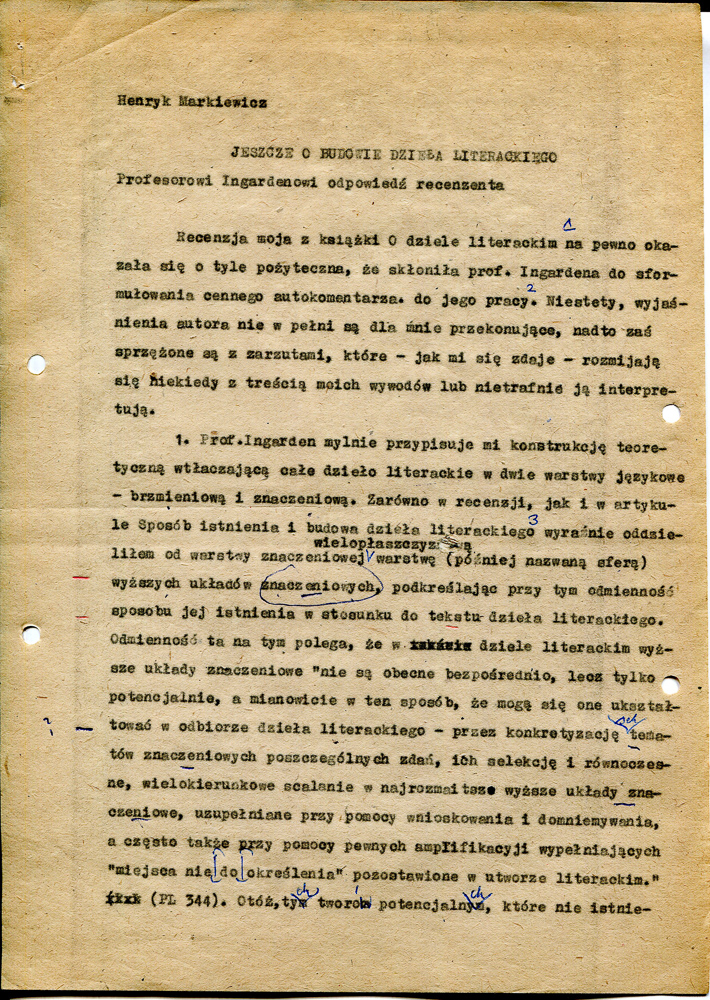

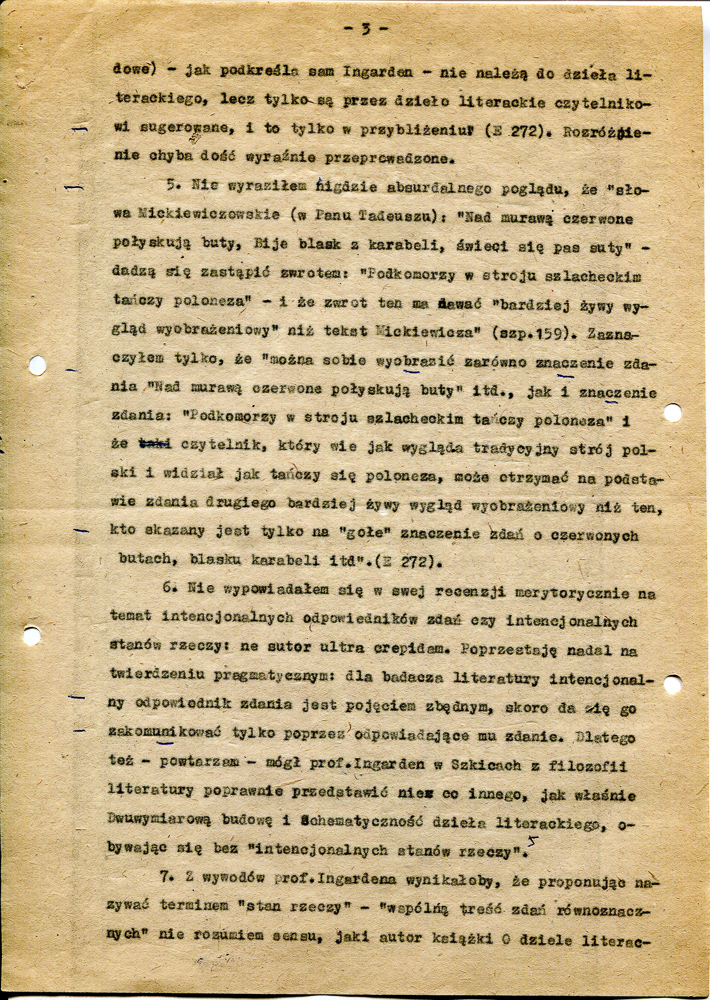
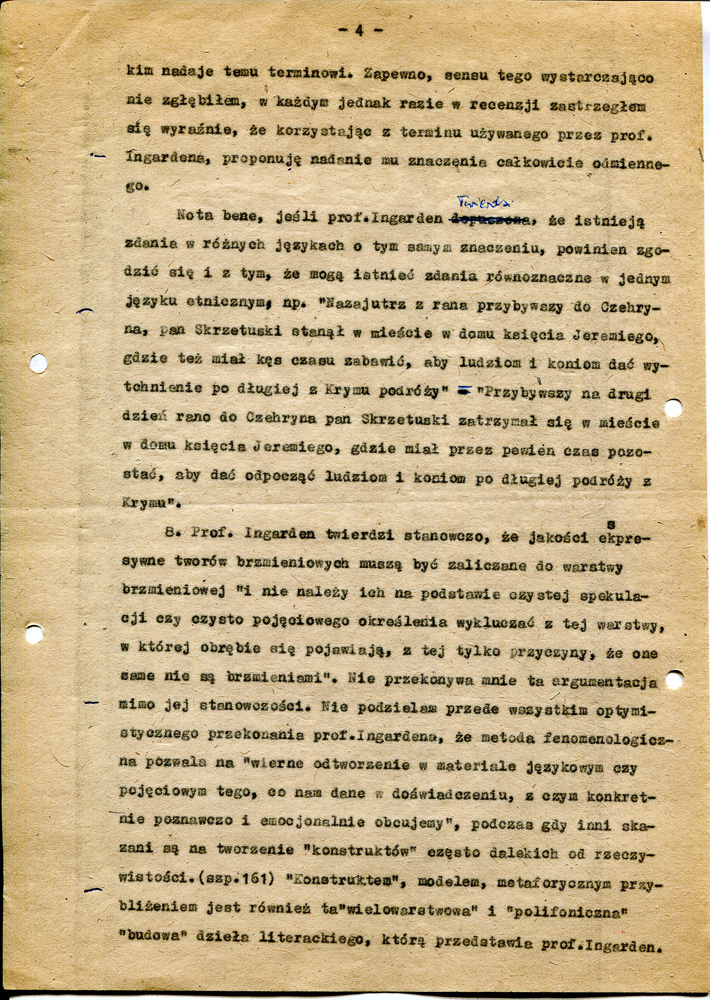

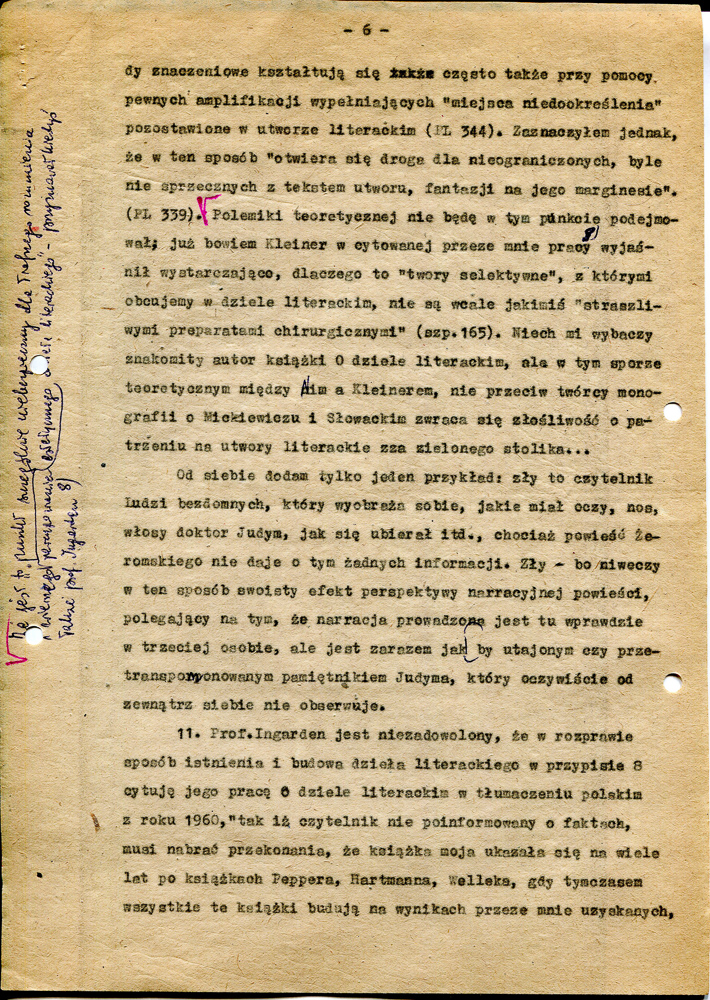
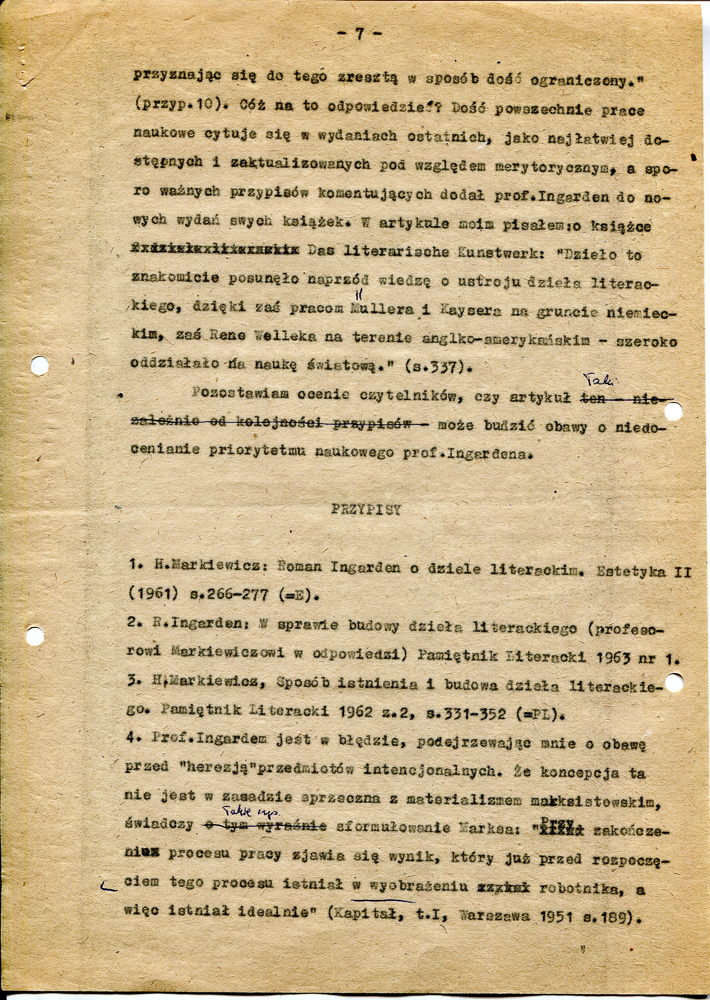

Review by Henryk Markiewicz of the book “The Literary Work of Art”
Henryk Markiewicz
v MORE ON THE CONSTRUCTION OF A LITERARY WORK
The reviewer’s response to Professor Ingarden
v v My review of the book The Literary Work of Art has certainly turned out to be sufficiently useful to incline Prof. Ingarden to formulate a valuable self-commentary on his work. Unfortunately, the author’s explanations do not entirely convince me, and, moreover, are linked with allegations which – as it seems to me – sometimes miss or misinterpret the content of my arguments.
v v 1. Ingarden mistakenly ascribes to me a theoretical construction which forces an entire literary work into two linguistic layers – sound and semantic. Both in the review and in the article ‘Sposób istnienia i budowy dzieła literackiego’ [The manner of existence and construction of a literary work] I have clearly distinguished the multidimensional layer (hereafter referred to as sphere) of higher semantic systems from the semantic layer, while emphasising the difference in its manner of existence in relation to the text of a literary work. This difference is based on the fact that in the literary work higher semantic systems ‘are not present directly, but only potentially, specifically, in such a way that they can take shape in the reception of a literary work – through substantiation of the semantic themes of particular sentences, their selection and simultaneous, multidirectional consolidation into various higher semantic systems, supplemented by inference and conjecture, and often with the help of certain supplementary amplifications of ‘places of indeterminacy’ remaining in a literary work’ (PL 344). Well, I prefer not to call these potential creations – which do not exist, but can only come into being and materialise in various ways in various readings of a literary work – ‘intentional objects’, even taking into account the illusory nature of the ‘existence’ of intentional objects, which Prof. Ingarden characterised so clearly in his book The Literary Work of Art (p. 20). I don’t believe that this position led to the rejection of ‘at least some, if not all products of human culture’, as Prof. Ingarden says, thus identifying me almost as the new Caliph Omar of the humanities.
v v 2. In that sphere of higher semantic systems, I essentially disconnect process and events from the field of ‘presented objects’, proceeding from the assumption that what happens to an object is not the object. Unnecessarily, however, Prof. Ingarden instructs us that ‘already Aristotle’ etc., since, as a component of IIIa of that sphere, the ‘plot’ evidently occurs as a chain of connected activities and states (E 271).
v v 3. Ingarden wonders why I introduced abstract concepts to the group of presented objects in the literary work. But what is one to call what is spoken of, for example, in works such as Treny [by Jan Kochanowski; Laments, or Threnodies], ‘Thou should be purchased, Wisdom, for much gold … ’ [trans. Dorothea Prall], ‘O sacred love of the beloved country … ’ [Ignacy Krasicki, ‘O sacred love of the beloved country’, transl. Christopher Kasparek], ‘To solitude I run as to the sea/To flee the heat of life … ’ [Adam Mickiewicz, ‘To Solitude’, transl. unknown]?
v v 4. Ingarden reports: ‘Professor Markiewicz wants to consider them [i.e. appearances] as the particular content of some sentences, whereas other statements of his show that he equally considers them to be specific ideas that the reader possesses in the course of reading the work’ (col. 155). Meanwhile, in the review, I wrote: ‘schemes of appearances are not separate components of a literary work, but only a certain variety – an appearance-creating variety – of the meanings of sentences and ‘higher semantic systems’, i.e. situational approaches and phases (E271), and subsequently: ‘appearances sensu stricto [Latin: limited, in the strict sense]’ (as opposed to schemes of appearance) – as Ingarden himself emphasises – do not belong to a literary work, but are only suggested by the literary work to the reader, and only approximately (E 272). The distinction is presumably clear enough.
v v 5. Nowhere did I express the absurd view that ‘the words of Mickiewicz (in Pan Tadeusz), ‘Nad murawą czerwone połyskują buty, Bije blask z karabeli, świeci się pas suty’ [His crimson boots upon the greensward flash, His sabre glitters and his rich-wrought sash (transl. Kenneth Mackenzie)] – can be replaced by the phrase ‘Podkomorzy w stroju szlacheckim tańczy poloneza’ [The chamberlain in his noble garb dances the polonaise] – and that this phrase is supposed to lend a ‘more vivid imaginative appearance’ than Mickiewicz’s text (col. 159). I indicated only that ‘it is possible to imagine both the meaning of the sentence ‘Nad murawą czerwone połyskują buty’ etc. and the meaning of the sentence ‘Podkomorzy w stroju szlacheckim tańczy poloneza’ and that a reader who knows what a traditional Polish costume looks like and has seen how a polonaise is danced can obtain a more vivid imaginative picture based on the latter sentence than one condemned to the ‘naked’ meaning of the sentences about the crimson boots, the glitter of the sabre, etc.’ (E 272).
v v 6. In my review, I did not comment substantively on the topic of intentional equivalents of sentences or intentional states of affairs: ne sutor ultra crepidam [Latin: the shoemaker not beyond the shoe, i.e. one should not pass judgment outside his area of expertise]. I continue to confine myself to this pragmatic statement: for a literary researcher, the intentional equivalent of a sentence is a superfluous concept, since it can be communicated only by means of the corresponding sentence. Thus, I repeat: Prof. Ingarden, in Sketches in the Philosophy of Literature, was able to correctly present nothing but the two-dimensional and schematic structure of a literary work, dispensing with ‘intentional states of affairs’.
v v 7. It would appear from Prof. Ingarden’s arguments that, in suggesting that we refer to the ‘common content of synonymous sentences’ using the term ‘state of affairs’, I misunderstand the meaning which the author of the book The Literary Work of Art assigns to this term. True, I failed to sufficiently fathom the sense of this term; in any case, however, in the review I explicitly expressed the reservation that, in making use of the term employed by Prof. Ingarden, I proposed to give it a completely different meaning.
v v Nota bene [Latin: note well], if Prof. Ingarden claims that sentences with the same meaning exist in different languages, this should agree with the fact that sentences with equivalent meanings may exist in one ethnic language, e.g. ‘Nazajutrz z rana przybywszy do Czehryna, pan Skrzetuski stanął w mieście w domu księcia Jeremiego, gdzie też miał kęs czasu zabawić, aby ludziom i koniom dać wytchnienie po długiej z Krymu podróży’ [Reaching Chigirin next morning, Pan Skshetuski stopped at the house of Prince Yeremi in the town, where he was to spend some time in giving rest to his men and horses after their long journey from the Crimea; from With Fire and Sword by Henryk Sienkiewicz, transl. Jeremiah Curtin] = ‘Przybywszy na drugi dzień rano do Czehryna pan Skrzetuski zatrzymał się w mieście w domu księcia Jeremiego, gdzie miał przez pewien czas pozostać, aby dać odpocząć ludziom i koniom po długiej podróży z Krymu’.
v v 8. Ingarden is adamant in stating that the expressive qualities of sound creations must be included in the sound layer ‘and they should not, on the basis of pure speculation or purely conceptual determination be excluded from this layer in which they appear, for the sole reason that they themselves are not sounds’. I am not convinced by this argument, despite its adamancy. First of all, I do not share Prof. Ingarden’s optimistic conviction that the phenomenological method enables ‘the faithful reproduction in language or conceptual material of what is given to us in experience, with which we deal cognitively and emotionally’, while others are doomed to create ‘constructs’ which are often far from reality (col. 161). This ‘multi-layered’, ‘polyphonic’ ‘construction’ of a literary work presented by Prof. Ingarden is equally a ‘construct’, a model, a metaphorical approximation. And one can demand of a model that it should be built transparently and consistently. If e.g. the emotional colouration of an expression or an interrogational modification of a sentence obtained by means of word formation belongs to the semantic layer, why should it belong to the sound layer, when it is created directly by means of sound? For example: why not include in the semantic layer the ‘irony’ contained in the statement: ‘pięknąś nowinę schował na ostatku!’ [you saved the good news for last] or the questioning note in the statement ‘podług ciebie mój szlachcicu, cnotą naszą – znieść niewolę?’ [according to you, my lord, to endure slavery is our virtue?]
v v 9. I agree with Prof. Ingarden that a literary work can exist without a ‘record’, and therefore the record is not part of the essence of a literary work. Nevertheless, I stand by the charge that Prof. Ingarden underestimates the role of this ‘record’, as he says, e.g.: ‘that for graphic moments, ‘non-transferrable’ in the spoken language, and at the same time ‘semantically burdened’, to occur in a literary work – as Prof. Markiewicz says – seems to me to be inconsistent with the facts’ (footnote 8). And how to convey exactly the semantics of capital letters and exclamation marks used by Wyspiański in spoken language (‘POEZJO, PRECZ!!!! JESTEŚ TYRANEM!!’ [POETRY, AWAY WITH YOU!!!! YOU ARE A TYRANT!!), the fanciful Old Polish spelling in Boy’s translations of Rabelais and Villon, or, finally, the provocative spelling of the futurists (Nusz w bżuhu [sic; Nuż w bżuhu, A nife in the gutz (a bulletin by Anatol Stern and others)]). Assuming, along with Professor Ingarden, that the graphic design is always something external to the literary work, neither is it possible to interpret the literary function of the so-called visual rhymes, calligrams, and assorted graphic tricks used in Tristram Shandy, let alone the ideograms of Chinese poetry.
v v 10. In connection with the places of ‘indeterminacy’, I never wrote that supplementing them is ‘unacceptable’; of course, I’ve clearly stated that higher semantic systems are also often formed with the help of certain amplifications supplementing ‘places of indeterminacy’ remaining in a literary work (PL 344). I noted, however, that in this way ‘a path is opened for unlimited – if not contradictory to the text of the work – fantasies in its margins’ (PL 339). Prof. Ingarden also admitted at one point that this is ‘a particularly dangerous point for the accurate understanding and faithful aesthetic cognition of a literary work’. I am not going to undertake a theoretical polemic at this point, since Kleiner, in the paper I’ve cited, has already sufficiently clarified the question of why these ‘selective creations’ that we deal with in a literary work are not at all ‘terrible surgical preparations’ of some sort (col. 165). May the excellent author of the book The Literary Work of Art forgive me, but in this theoretical dispute between him and Kleiner, it is not against the creator of the monograph on Mickiewicz and Słowacki that malice in connection with looking at a work of literature from the umpire’s chair is directed …
v v Concerning myself, I’ll add only one example: The reader of Homeless People who imagines what kind of eyes, nose, and hair Dr Judym had, or how he dressed, etc., although Żeromski’s novel gives no information about it, is wrong. Wrong, because in this manner he destroys the peculiar effect of the novel’s narrative perspective, which relies on the narrative which is admittedly conducted here in the third person, but at the same time is like a latent or transposed diary written by Judym, who of course does not observe himself from outside.
v v 11. Ingarden is dissatisfied that, in my dissertation on the manner of existence and construction of a literary work, I cite, in footnote 8, his paper The Literary Work of Art in its 1960 Polish translation ‘such that the reader uninformed of the facts must be convinced that my book appeared many years after those of Popper, Hartmann, and Wellek, whereas all of these books build on the results I obtained, while admitting to it in a rather limited way’ (footnote 10). What can I say in reply? Quite commonly, academic papers are quoted in recent editions, as these are the most easily accessed and updated in substantive terms, and Prof. Ingarden has added numerous important commentary footnotes to the new editions of his books. In my article I wrote, concerning Das literarische Kunstwerk: ‘This work greatly advanced knowledge concerning the structure of a literary work; thanks to the works of Muller and Kayser in Germany and René Wellek in the Anglo-American sphere, it had a wide impact on world learning’ (p. 337).
v v I leave it to the readers to decide whether such an article might raise concerns about underestimation of the academic priority of Prof. Ingarden.
FOOTNOTES
- Markiewicz: ‘Roman Ingarden o dziele literackim’ [Roman Ingarden on the Literary Work]. Estetyka II [Aesthetics II] (1961) pp. 266–267 (= E).
- Ingarden: ‘W sprawie budowy dzieła literackiego (profesorowi Markiewiczowi w odpowiedzi)’ [On the construction of a literary work (in response to Professor Markiewicz)] Pamiętnik Literacki [Literary Diary] 1963, no. 1.
- Markiewicz, ‘Sposób istnienia i budowa dzieła literackiego’ [The manner of existence and construction of a literary work]. Pamiętnik Literacki 1962, no. 2, pp. 331–332 (= PL).
- Professor Ingarden is mistaken in suspecting me of fearing the ‘heresy’ of intentional objects. That this concept is not, in principle, contrary to Marxist materialism is evidenced as well by e.g. the formulation of Marx: ‘At the completion of the work process a result appears, a result which, prior to the beginning of this process, existed in the imagination of the worker, and thus existed in an ideal fashion’ (Das Kapital, vol. 1, Warsaw 1951, p. 189).
- Given this opportunity, I will add only that Prof. Ingarden’s concept of ‘meaning’ (as opposed to that of the ‘intentional counterpart’) would be clearer if it were called ‘designation’; this is, in fact, the word that Prof. Ingarden uses several times to explain what meaning is.
- However, here, too, the matter is far from simple: ultimately, what determines the identity of the Iliad or Odyssey is the record and not the typical sound form, because, first, we don’t know what it was like when recited by the Greeks, and second, it has changed many times over the centuries when recited by representatives of different nations. In fact, we don’t even know exactly how Kochanowski read his Treny [Laments, Threnodies].
- ‘The rhyme of Mallarm is always a visual rhyme. He is simply faithful to the traditions of French poetry, which, from the time of Malherbe (“He demanded”, says Racan, “that it should rhyme in equal measure for the eyes as for the ears”), was written and printed poetry’. (A. Thibaudet, La Poésie de Stéphane Mallarmé [The poetry of Stéphane Mallarmé]. Paris [1926] 1959, p. 246.
- Kleiner, ‘Rola pamięci w recepcji dzieła literackiego i w jego strukturze’ [The role of memory in the reception and structure of a literary work]. In: Studia z zakresu teorii literatury [Studies in literary theory], 2nd (extended) edition. Lublin 1961, pp. 61–63.
- Ingarden, ‘O poznawaniu dzieła literackiego’ [The Cognition of the Literary Work of Art]. In: Studia z estetyki [Studies in Aesthetics]. Warsaw 1937, vol. I, p. 39.
